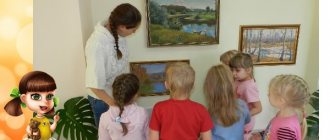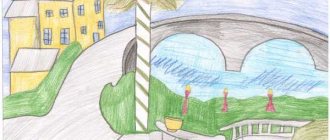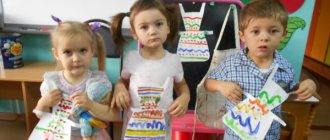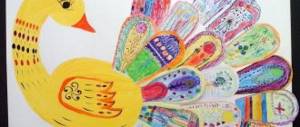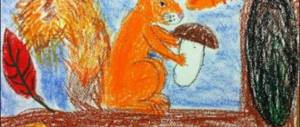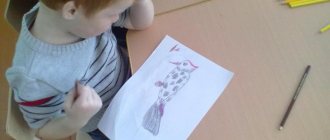Planning and conducting classes
KomarovaPLANNING AND CONDUCTING CLASSES
An important means of aesthetic education of children is visual activity (drawing, modeling, appliqué). It allows children to express in drawings, modeling, and applications their idea of the world around them, their understanding of it and their attitude towards it. Therefore, mastering visual arts in kindergarten is very important for a child: a preschooler gets the opportunity to independently create a drawing, sculpt any object, cut out and paste a picture. These activities bring joy to children, create a positive emotional mood, and promote the development of creativity. In the process of artistic activity, children develop aesthetic perception, figurative ideas and imagination, aesthetic feelings (shape, color, composition). However, this does not happen on its own, but under the condition of systematic, purposeful and at the same time subtle and sensitive guidance of the teacher, taking into account the specifics of the child’s visual creativity.
The lessons offered in this book are based on the following principles:
- Fine arts classes are a means of educating children. They develop aesthetic perception, aesthetic feelings, imagination, creativity, and form imaginative ideas.
- Drawing, sculpting, and applique classes are part of the multifaceted work of a kindergarten, so visual activities should be closely related to all aspects of educational work (getting to know the environment, playing, reading books, music classes, etc.), during which children receive various impressions, knowledge. For the image, it is important to choose the most striking events from the lives of children, so that the proposed topic is familiar to them, arouses their interest, a positive emotional mood, and a desire to draw, sculpt or cut and paste.
- Of particular importance is the relationship between drawing, sculpting, and appliqué activities and play. This relationship is dictated, on the one hand, by the commonality that exists between the two types of activity (reflection of the impressions of the surrounding life); with other
beets.
Younger children are the last to be invited to the lesson, and the teacher teaches them sculpting techniques using straight movements of the palms. At the first drawing lesson, children of the middle group, as well as senior and preparatory groups, are asked to reflect on their impressions of the summer. At this time, children of the younger group are introduced to pencils and paper. The older children are invited to the lesson first and, having given them a task, the younger children are taught.
In a multi-age group, you can more often use a collective form of classes, in which each age group solves its part of the image in accordance with the requirements of the program.
It is better to combine tasks of one type of visual activity in class. This will make it easier for the teacher to prepare materials for the lesson and analyze children’s work, which will be interesting and useful for younger children, especially if the image was made on one topic. In this case, children will see a variety of solutions.
The classes offered in the book are arranged as they should be carried out over the course of a month or a year. Such classes were held in many kindergartens in Moscow and the Moscow region, Minsk, Tbilisi, Riga, and Chisinau. The content and methodology of classes were refined and improved.
The use of the methodological recommendations of this manual allowed teachers to develop the visual creativity of preschool children, to form in them the knowledge, skills and abilities necessary for the figurative embodiment of objects and phenomena of reality.
CLASSES SECOND JUNIOR GROUP
SEPTEMBER
0.7 Mb.
Share with your friends:
Abstract of the GCD on decorative drawing in the preparatory group “Painting the Filimonovskaya toy”
Summary of GCD for decorative drawing in the preparatory group.
Theme "Painting of the Filimonov toy"
Goal: Mastering the basics of decorative and applied arts.
Acquaintance with folk craft - Filimonovskaya toy, its characteristic features. Conveying mood in creative work using color, composition, volume, material.
Tasks
Educational:
Expand your understanding of the craft of toy makers.
Learn to paint cut-out paper toy templates with elements of Filimonov painting, and correctly use the basic colors of the craft.
Educational:
Develop children's sense of color and shape.
Develop imagination and creativity.
Educational:
To cultivate interest and love for the beauty of the surrounding world, for folk art, respect for the work of folk craftsmen, pride in one’s homeland.
Give children the opportunity to feel like folk craftsmen.
Materials and equipment:
Toy whistles (hens, cockerels, birds, ladies, soldiers, goats, rams, bears, pigs, etc.); teaching aid (table) with characteristic color combinations and decorative elements; gouache paints, brushes, jars of water.
Preliminary work:
Conversations with children about folk arts and crafts; viewing albums, photographs, drawings, folk crafts, memorizing poems about folk crafts, visual activities on this topic.
GCD move.
Organizing time
The teacher draws the children's attention to the exhibition of Filimonov toys, reads a poem
Educator: There is a village near Tula
The name is Filimonovo . And the craftswomen live there, bringing good things to homes. And the good there is not simple And not gold, silver.
It's called a Filimonovskaya toy.
The necks are strongly stretched out, And the cow, and the giraffe, And the bear, like the Serpent Gorynych Only animals, birds, horses, Young ladies, soldiers. Both cows and bears were liked by the children, so that the heart would be warmed with goodness and beauty, and so that the fairy tale would never leave us.
Children look at the exhibits and share their impressions.
Teacher's story
Throughout Mother Rus' and far beyond its borders, painted whistle toys are known and loved. They got their name from the village of Filimonovo.
It is unknown who made the first toys here and when, we only know that they have been made for a very long time. One of the legends says that the potter Philemon came to these places, discovered deposits of excellent clay and began to sculpt pots and toys from it. The place where he settled was called Filimonovo.
They make toys from clay. It is soft, obedient to the hands and colorful - white, pink, yellow, orange and even black. Filimonovsky craftsmen sculpt from clay - cows, deer, goats with long necks and large horns. They look more like fairy tale animals than real pets.
Filimonovsky toys are elegant, colorful, bright, cheerful, funny.
Educator: Such whistle toys are made by craftswomen with a kind heart and warm, skillful, strong hands. The molded whistle toys are fired in special ovens. Previously, these were earthen ovens that were made in ravines. A brick oven was built there, in which dishes were placed in dense rows, and the voids between the pots were filled with whistles. The roasting was an unusually colorful spectacle. These mighty fires burned until late at night, illuminating the red-hot pots and toys. Toys in the fire first become red-hot and then white-hot. And when the toys cool down, they become white and pink and hard as stone.
Pay attention to the shape of the toys. What is she like? (extended)
It's all about the natural properties of local clay. She is fat and plastic. When drying, the clay quickly becomes covered with cracks; it has to be constantly smoothed with a damp hand, involuntarily narrowing and stretching the body of the figure. This is where refined, elongated, but surprisingly graceful forms appear.
After firing, the toys are painted. Typical colors for this fishery are yellow, red, and green.
The following pattern elements are used for painting: stripes, lines, dots, circles. Lines in various combinations give birth to suns, Christmas trees, rosettes, and geometric patterns. Animals and birds are always painted in a certain order: alternating stripes of different colors run across the body and neck, and only the head and chest are painted in one color, usually yellow. The ladies' jackets and the soldiers' shirts are painted the same color, mostly red. But how much creativity comes from the masters when they draw patterns on the skirts, aprons and pants of their dolls! Only the faces of the toys remain pure white, only the dots are the eyes, the spots are the mouth.
We made toys for the spring holiday, which is called “Whistling”. Spring folk festivals and festivities took place on a large square. On the trays and counters of the crowded spring fair they were selling cheerful goods. Adults and children eagerly took it apart. The whole area was filled with whistling sounds. The people's festivities were noisy, but the loudest sound was the loud whistling. And, of course, they played fun folk games. Let's play the game "Carousel" too.
Physical school
Children stand in a round dance and walk in a circle, reading the poem “Carousel” by V. Berestov.
We are miles away
The carousel won't roll away.
But where can we go without looking back?
Are hares and horses racing?
We're going on a carousel
From fun to fun.
Children begin to read in a quiet voice, walking slowly in a circle. Then they speed up the pace of the poem, and at the same time slowly run after each other.
Educator: Craftsmen can do everything, but you want to show your skills? Become real folk craftsmen and paint Filimonov toys? I invite you to a creative workshop.
Work in a creative workshop
Children choose cut out toy stencils.
The teacher discusses with the children the procedure for completing the work. The child is shown drawing individual elements of Filimonov's painting on a sheet of paper. During the work, the teacher provides children with creative freedom and provides individual assistance.
Analysis of children's works
Educator: Come on, folk craftsmen, show your toys, let's see how beautiful you have turned out. An exhibition of children's works is being organized.
Educator: Well done guys, they did a great job. Showed excellent skills and knowledge. You have turned out to be wonderful masters of the Filimonov toy!
Bottom line.
Educator: Did you like the Filimonov toy? Which one is the most? The Filimonovskaya whistle, which glorified its village in our country and far beyond its borders, must be preserved for the future.
Where did you come to us like this? Everything is simple, no tricky tricks. With a long neck and painted, For children's play and fun. I fell in love with you in early childhood - my grandmother was a craftswoman. You came to me by inheritance From beautiful people from the village. Distances are not scary for you. You are from the ancestors of distant times. These clay sculptures ring the bells of Rus'.
